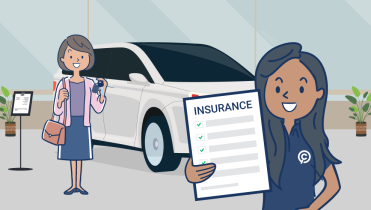less than
2 mins
- Home
- Personal Finance
- Guide
- Car Insurance for P Platers
Car Insurance for P Platers
Key Points
P-plate drivers commonly face higher car insurance costs compared to other motorists.
Comparing policies from different providers helps you find the most competitively priced premium.
Comprehensive insurance premiums for P-plate drivers average between $110-120 per month for a budget policy.
For young drivers holding provisional licenses (i.e., P-Platers), finding affordable car insurance can be daunting. This guide provides valuable insights into cover options, factors influencing costs, and essential tips for securing the best deal.
Compare & SaveHere's a breakdown of the main types of cover options available to you as a P-Plater:
1. Comprehensive Car Insurance:
Covers your car for theft, vandalism, storms, flood, hail, fire, key replacement, emergency accommodation, hire cars, and accidental damage.
This the most extensive cover available to you, though inclusions and restrictions vary widely among the different providers.
2. Third Party, Fire and Theft Cover:
Protects your car against theft, fire damage, and damage to other people’s property.
Suitable for P-Platers seeking additional cover, without a hefty price tag.
3. Third Party Property Damage Cover:
This basic policy covers damage to other people’s vehicles or property - but it doesn’t cover your car.
Recommended for P-Platers with budget constraints, and/or those driving cheaper cars.
4. Compulsory Third Party (CTP):
Offers protection to the driver at fault for any accident that causes injury to another person. Does not cover damage to any property at all - including any cars involved.
Everyone needs this one. It’s your Greenslip insurance and it’s mandatory for all drivers on Australian roads.
Learn more about car insurance with these guides
The Cheapest Car Insurance for P Platers:
Consider comprehensive insurance if you’re struggling to pay for your car repairs, as your premium may decrease over time, especially if you’re:
a woman,
maintain a claim-free driving record,
don’t have a car loan (or pay yours off),
don’t drive a lot,
opt for a voluntary excess,
eligible for available discounts from your insurer,
and are able to park your vehicle securely overnight (e.g. in a garage).
Car Insurance Cost-Saving Measures for P-Platers
Car insurance serves as financial protection in the event of accidents or damage to your vehicle. When determining the right car insurance for your situation, consider the type of cover you want, the inclusions you need, and any associated costs you’re willing - or unwilling - to pay out.
Cover Under Parents' Insurance:
If you drive your parents' car, becoming an additional driver on their insurance policy is a possibility. While this may increase their overall policy cost, it’s still probably cheaper than getting separate cover. Keep in mind that drivers under 25 years old may incur an additional excess if you make any claims.
Personal Car Insurance Considerations:
For those driving their own car, securing comprehensive car insurance is a good idea. This cover extends to damages on your car, as well as limiting your liability for damage to other vehicles and property.
To reduce your annual car insurance expenses, consider the following measures:
Secure Parking: Keeping your car in a secure location reduces risk and may lead to lower premiums.
Discounts: Explore online purchase discounts, multi-policy discounts, and safe driving course incentives.
Higher Excess: Opting for a policy with a higher excess can result in lower premiums.
Safe Driving Practices: Maintaining a no-claims driving record can earn you insurance discounts.
Payment Frequency: Annual payments might offer cheaper rates than monthly instalments.
Selective Policy Inclusions: Evaluate optional extras, such as windscreen protection.
Comparing policies from different providers is a valuable step in finding cover that aligns with your needs and budget.
What's new in car insurance - Feb 2025
Cheaper cover: A few providers have slashed prices for comprehensive policies.
EV insurance: Cover options are expanding as more Aussies go electric.
Tech-driven savings: Telematics are driving discounts for safer drivers.
Frequently Asked Questions:
Why does car insurance for P-Platers cost more?
Statistically, drivers under 25, especially P-Platers, are more prone to accidents due to their limited driving experience.
What's the best car insurance for P platers?
There’s no universal best insurance. It’s a good idea to research a range of different insurers and find out what they have to offer you. Consider features like how much excess they’ll ask for if you need to make a claim, and what benefits they offer.
What's the cheapest car insurance for P Platers?
Currently, comprehensive premiums for P-plate drivers average between $110-120 per month for a budget policy, though quotes vary widely across policies, insurers - and of course, your specific circumstances.
Do I have to get my own car insurance policy, or can I stay on my parents' policy?
There’s no requirement for you to get a separate car insurance policy. Staying on your parents' policy can probably save you money.
Important Note: The owner of the insured car must be named as the main driver on the insurance policy and the policy ought to be in their name, or any claim you make on the policy could be denied.
Can I put my insurance under my parents' names if they don't own the car?
This isn’t a good idea. It can void your policy and likely affect your ability to take out insurance in the future. You’re also unlikely to see any claims decided in your favour.
Compare & SaveConclusion
Taking the wheel independently after passing your driving test is a significant step toward autonomy. However, before affixing those P-plates and hitting the road, it's smart to consider your car insurance options.
By understanding cover options, considering various factors, and exploring FAQs, young drivers can make informed decisions and find affordable insurance solutions.
Sources
Things You Should Know
Compare Club Car Insurance is an online financial comparison service and is owned and operated by Compare Club Australia Pty Ltd (ACN 634 600 007). Compare Club does not compare all brands or all products offered by all brands.
The financial products compared on this website do not necessarily compare all features that may be relevant to you. Please check with a financial professional before you make any major financial decisions.
Any advice given here is general and has been prepared without considering your current objectives, financial situation or needs. Therefore, before acting on this advice, you should consider the appropriateness of the advice having regard to those objectives, situation or needs.
You should consider the insurers PDS prior to making the decision to purchase their product. For more information please read our Financial Services Guide (FSG) which contains further information about how our service works and how we make money.
Paul Coughran is the General Manager of Emerging Verticals at Compare Club. Paul has over 20 years of experience across a wide range of industries including Banking and Finance, Telecommunications and Energy. Paul leads a team of trusted experts dedicated to helping individuals make informed decisions about their insurance and utilities needs.

Meet our car insurance expert, Paul Coughran
Paul's top car insurance tips:
- 1
Regularly compare your insurance policies – You could be paying for cover you don’t need. Shopping around every so often can save you a fair bit, maybe even hundreds each year.
- 2
Don’t just look at the premium—check the excess too. While a higher excess might bring down your premium, remember you’ll have to fork out more if you do need to claim.
- 3
Double-check what’s included in your policy. Extras like windscreen cover or roadside assistance might not be part of the deal and could cost you more.
- 4
If you don’t drive much, consider usage-based insurance. Some policies base your cost on how much you actually drive, if you work from home or only use your car for short trips this might be a much better option.




































